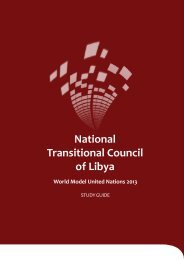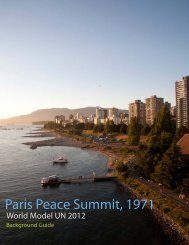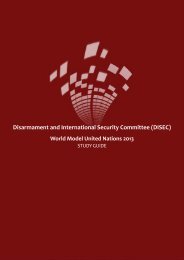Disarmament and International Security - World Model United Nations
Disarmament and International Security - World Model United Nations
Disarmament and International Security - World Model United Nations
Create successful ePaper yourself
Turn your PDF publications into a flip-book with our unique Google optimized e-Paper software.
such as the structure of the ocean floor, sediment thickness,<br />
<strong>and</strong> ocean depth. Problems arise when these factors are<br />
a matter of dispute, as it is the case with the Lomonosov<br />
Ridge, where determining whether this geological<br />
formation is part of the continental shelf of Canada, Russia,<br />
or Greenl<strong>and</strong> is crucial to establishing which country has<br />
sovereign rights over the seabed around the North Pole. 74<br />
To control claims extending beyond 200 nautical miles, or<br />
to h<strong>and</strong>le conflicting claims, the Commission on the Limits<br />
of the Continental Shelf was established. The Commission<br />
considers evidence data submitted by coastal states <strong>and</strong><br />
makes recommendations to the <strong>United</strong> <strong>Nations</strong>.<br />
From its very conclusion in 1982,<br />
the UNCLOS was not considered<br />
a final treatment of the Law of the<br />
Sea, but rather a ‘sea constitution’,<br />
intended to provide an essential<br />
framework for future solutions.<br />
The UNCLOS was supposed to<br />
serve as a basis for dealing with a<br />
myriad of legal issues that would<br />
arise in drafting more specific,<br />
regional treaties. Nowadays, some<br />
experts <strong>and</strong> politicians call for a<br />
new Arctic treaty, modeled on the<br />
Antarctic agreement.<br />
The Ilulissat Declaration<br />
In May 2008, representatives of the five coastal States<br />
bordering on the Arctic Ocean – Canada, Denmark,<br />
Norway, the Russian Federation, <strong>and</strong> the <strong>United</strong> States of<br />
America – met at the political level in Ilulissat, Greenl<strong>and</strong>,<br />
to hold discussions about the future of the Arctic region.<br />
The result of these discussions was the Ilulissat Declaration,<br />
adopted on 28 May 2008, which presents the common<br />
position of the five Arctic states in regards to climate change,<br />
maritime safety, <strong>and</strong> sovereign rights in the area. One major<br />
objective of the Declaration, accepted by nations gathered at<br />
the conference, was the blockage of any ‘new comprehensive<br />
international legal regime to govern the Arctic Ocean.’ 75<br />
The parties of the Declaration confirmed that the Law of<br />
the Sea Convention, along with the <strong>International</strong> Maritime<br />
Organization <strong>and</strong> the Arctic Council, form the core of<br />
the regime that governs the Arctic, <strong>and</strong> that within the<br />
framework of this regime the five Arctic states recognized<br />
their responsibility to manage activities in the region,<br />
including both development <strong>and</strong> environmental protection. 76<br />
In the Declaration, the five nations also pledged to ‘remain<br />
committed to this legal framework <strong>and</strong> to the orderly<br />
In the Declaration, the five<br />
nations also pledged to<br />
‘remain committed to this<br />
legal framework <strong>and</strong> to<br />
the orderly settlement of<br />
any possible overlapping<br />
claims.’<br />
settlement of any possible overlapping claims.’ 77<br />
The consequences of the Declaration were twofold. In<br />
reaffirming the role of the existing international law in<br />
governing the issues concerning the Arctic, the signatories<br />
also recognized that other states would participate in<br />
development <strong>and</strong> protection of the Arctic, through the<br />
international Maritime Organization, the Arctic Council,<br />
<strong>and</strong> other relevant international forums. However, the<br />
Declaration also made it clear that there will be no<br />
negotiation of an alternative regime for the Arctic Ocean<br />
that would be contrary to the provisions of the UNCLOS. 78<br />
Proposed Solutions<br />
An Arctic Treaty<br />
With the Arctic ice melting,<br />
an increased interest in<br />
the Arctic’s natural resources <strong>and</strong><br />
navigation, <strong>and</strong> a recent phenomenon<br />
of many nations piling up arms <strong>and</strong><br />
planting flags in the region, calls have<br />
emerged for a comprehensive Arctic<br />
Treaty to govern the ‘lawless’ Arctic<br />
region. Many non-governmental<br />
organizations <strong>and</strong> some politicians<br />
are arguing for an international<br />
agreement that would adopt a legal<br />
framework for dealing with issues<br />
such as polar oil <strong>and</strong> mineral exploration, commercial activity,<br />
maritime security, navigation <strong>and</strong> environmental regulation.<br />
Such an agreement could be achieved under the auspices of<br />
the <strong>United</strong> <strong>Nations</strong> <strong>and</strong> could replace the <strong>United</strong> <strong>Nations</strong><br />
Convention on the Law of the Sea as the primary piece of<br />
legislation concerning the Arctic region, being modeled after<br />
the Antarctic Treaty of the early 1960s. In the same way as<br />
the Antarctic Treaty does, an Arctic Treaty could set aside the<br />
Arctic as a scientific preserve <strong>and</strong> ban all military activity in that<br />
area, while freezing all territorial claims. Proponents of a new<br />
Arctic Treaty believe that such an agreement could facilitate<br />
arranging for sustainable development of Arctic resources,<br />
developing shipping shortcuts through the northern passages,<br />
setting technological st<strong>and</strong>ards for ships that navigate the icy<br />
waters <strong>and</strong> guarding the welfare of the more than one million<br />
indigenous people living within the Arctic Circle. 79<br />
On the other h<strong>and</strong>, many governments, including the major<br />
Arctic powers, are strongly opposed to establishing another<br />
treaty regime in the Arctic <strong>and</strong> believe that the UNCLOS <strong>and</strong><br />
other existing international law provides a comprehensive set<br />
Harvard <strong>World</strong>MUN 2012<br />
<strong>Disarmament</strong> <strong>and</strong> <strong>International</strong> <strong>Security</strong> 15 15

















